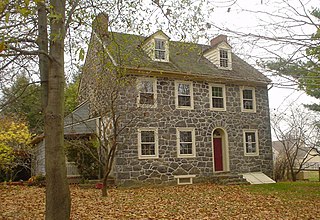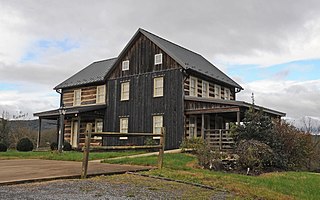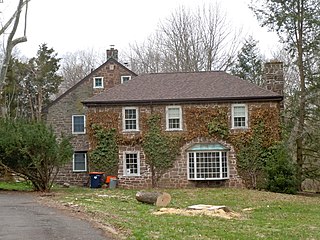
Robert Parkinson Farm is a historic property in Morris Township, Pennsylvania. The contributing buildings are the c. 1830 house, c. 1830 banked barn, c. 1870 sheep barn, c. 1880 hay shed, c. 1880 spring house, and a c. 1920 privy. The house is a five-bay center passage farmhouse with an attached rear kitchen in a T-shaped floor plan. The Parkinson Farm is an example of an early 19th-century sheep farm, and it continued to operate as such until about 1960.

The Booth Farm is a historic farmhouse located in Bethel Township, Delaware County. The farmhouse was built in the Federal style in 1819 and a barn was also built about the same time. The roughly 77 acre farm was bought by Thomas Booth in the 1790s and has been used as a tenant farm throughout much of its history. He built the farmhouse for his son James who was born in 1790. Four following generations, all named Thomas Booth, have owned the farm into the 21st century.
Potter–Allison Farm is a historic farm complex and national historic district located at Potter Township, Centre County, Pennsylvania. The district includes nine contributing buildings and one contributing site in Centre Hall. The district includes the Potter–Allison House, 19th century wood barn, and a variety of outbuildings including a hog barn, equipment buildings, corn crib, stone slaughterhouse, and a springhouse. Also on the property are the remains of milling and tanning operations. The Georgian-style house was built about 1817, with a Victorian addition dating to the 1850s. It is a 2 1/2-story brick dwelling. The property was originally owned and developed by General James Potter (1729–1789), who built a log cabin and grist mill. The property was acquired by the locally prominent Allison family in 1849.

Fort Hunter Historic District is a national historic district located at Fort Hunter, Dauphin County, Pennsylvania. The district includes six contributing buildings, four contributing sites, and one contributing structure. The area has seen continuous settlement since the early 1700s and once was the site of an early supply fort and garrison. Also in the district are the remains of a section of the Pennsylvania Canal. Notable buildings include the separately listed Archibald McAllister House, a spring house, Everhart Covered Bridge, large frame barn (1876), corn crib, farm house, blacksmith shop, stone stable barn, Hunter's House or Old Hotel, ice house, and archaeological sites for Fort Hunter, the garrison, Hunter's Mill, and the Pennsylvania Canal.

Spring Grove Farm and Distillery is a historic farm complex and distillery site located at Antrim Township in Franklin County, Pennsylvania, USA. The house was built in 1867, and is a two-story, "T"-shaped, brick dwelling in the Greek Revival style. Also on the property are a contributing two-story, four bay brick building believed to have housed a cooper's shop and residence, brick summer kitchen, brick smoke house, frame pumphouse, large brick end bank barn with a slate roof, frame wagon shed, brick carriage house, stone mill (1803) and the site of the Spring Grove Distillery. The distiller ceased to operate in 1920.

Rock Hill Farm, also known as the Davis-Stauffer Farm Complex, is a historic home and farm and national historic district located at Montgomery Township in Franklin County, Pennsylvania. The district includes 12 contributing buildings, 2 contributing sites, and 3 contributing structures. They are associated with three areas: the Davis-Chamber farmstead, Eliab Negley House, and Joseph Negley farmstead. Contributing components of the Davis-Chamber farmstead include the log and frame main house, 18th century log smokehouse, limestone milk house, frame wash house, frame outhouse, frame wagon shed, and a frame barn with concrete sile. The property also includes a stone wall, and the archaeological remains of earlier buildings including a limestone mill dismantled about 1930. The Eliab Negley House is a log dwelling built between 1810 and 1823. The Joseph Negley farmstead includes a Greek Revival-style dwelling built between 1836 and 1850, with later modifications about 1900. Also on the property are a contributing 19th century smokehouse, a frame wagon shed, and a large shed.

Oregon Mill Complex, also known as Oregon Pike Mill & House; Oregon Mill-Twin Springs Farm, is a historic grist mill complex located in Oregon, Manheim Township, Lancaster County, Pennsylvania along Lititz Run. The mill was built in 1814, and is a two- to three-story, limestone structure. It is five bay by three bay, and has a gable roof. The mill was rebuilt in 1909. The former miller's house is a 2 1/2-story, stucco coated stone building with a hipped roof and in a conservative Italianate style. The limestone end barn was built between 1798 and 1815, and features a high-pitched gable roof.

Windom Mill Farm is a historic farm and national historic district located at Manor Township, Lancaster County, Pennsylvania. The district includes 12 contributing buildings and 1 contributing site. They are the main farmhouse, a stone end Pennsylvania bank barn, a mill (1810), the miller's house, a former tavern now a dwelling, two tobacco sheds, a frame corn barn, a garage, a milk house, a pigpen, and a former carriage house. The contributing site is the remains of the family cemetery. The farmhouse was built about 1780, and is a 2 1/2-story, five bay by two bay, limestone dwelling with a full-width front porch. It is in the Federal style.

Kirks Mills Historic District is a national historic district located at Little Britain Township, Lancaster County, Pennsylvania, United States. The district includes 12 contributing buildings in the village of Kirks Mills. Those buildings are: Jacob Kirk's Mansion House, Brick Mill / Kirk's Mill, the brick miller's house, stone and log barn converted to a residence in 1975, Joseph Reynold's House (1825), Eastland Friend's Meeting and Tenant House, Ephriam B. Lynch House (1880s), Harry Reynolds House, Manuel Reynolds House, Eastland School House (1838), and Log House. The Jacob Kirk's Mansion House is a three-story, brick dwelling with a two-story ell. It features a full porch on the front and right sides. Kirk's Mill is a 2+1⁄2-story brick building with a slate gable roof. It was remodeled to a residence about 1940.

Andrews Bridge Historic District is a national historic district located at Colerain Township, Lancaster County, Pennsylvania, United States. The district includes nine contributing buildings in the rural crossroads village of Andrews Bridge. The buildings were built between 1800 and 1850 and are the old Roop's Hotel, a former mill also known as Dobbin's Store, four dwellings, and three barns.

Bucher Thal Historic District, also known as Bucher Valley Historic District, is a national historic district located at East Cocalico Township, Lancaster County, Pennsylvania. The district includes 12 contributing buildings and 1 contributing structure in the rural hamlet of Bucher Thal. The buildings were built between about 1760 and 1900 and include the Bear's Mill, Jacob Keller House, Keller Barn (1892), Lutz House or Brookside Farm, Eberly-Lutz House, and Lutz Barn (1873).

Kuster Mill, also known as Custer's Fulling Mill and Skippack Creek Farm, is a historic fulling mill located in Evansburg State Park on Skippack Creek at Collegeville, Skippack Township, Montgomery County, Pennsylvania. The complex includes three contributing buildings and one contributing structure. They are the original mill, mill race, a stone house, and Dutch bank barn.

Nyce Farm, also known as the Eshback Farm and Van Gordon House, is a historic home and farm complex located in the Delaware Water Gap National Recreation Area at Lehman Township, Pike County, Pennsylvania. The farmhouse dated to the early 19th century, and was a large 2+1⁄2-story, five-bay, clapboard-sided frame dwelling. The original farmhouse, known as the Jacobus Van Gorden House, is a 2+1⁄2-story, three-bay, rubble sandstone dwelling. Also on the property are five contributing barn, garage, and storage buildings.

John Brown Farm, Tannery & Museum, 17620 John Brown Rd., Guys Mills, PA 16327, is a historic archaeological site located in Richmond Township, Crawford County, Pennsylvania. The tannery was built in 1825 by famed abolitionist John Brown (1800–1859), who lived on the site from 1825 to 1835. The tannery was about 0.25 miles (0.40 km) from the new Pennsylvania and Ohio Canal.

Borneman Mill, also known as Stauffer Mill, is a historic "farm mill" located in Washington Township, Berks County, Pennsylvania. The mill was built to perform farm chores with water power. The mill was built before 1860, and is a two-story, with basement, post-and-beam building with vertical siding. It measures 21 feet, 6 inches, by 24 feet, 6 inches. The mill powered operations in the nearby stone bank barn by use of a cable drive system. Also on the property are a contributing farmhouse and smokehouse.

Mill Tract Farm, also known as the George Boone Homestead, is a historic house and farm complex located in Exeter Township, Berks County, Pennsylvania. The original section of the house was built about 1750, with a western addition built about 1790 and rear additions completed between 1790 and 1820. It is a two-story, five-bay, L-shaped fieldstone dwelling in the Georgian style. Also on the property are a 2+1⁄2-story, stone grist mill ; early-19th-century, 2+1⁄2-story, fieldstone tenant house; large, late-18th-century stone-and-frame barn; stone pig pen; and two-story, stone horse barn. The grist mill was purportedly built by George Boone, III, grandfather of frontiersman Daniel Boone, who received the original land grant.

Rieser–Shoemaker Farm is a historic farm complex and national historic district located in Bern Township, Berks County, Pennsylvania. It has seven contributing 'buildings' and two contributing 'structures'. They are a 2 1/2-story, vernacular Federal brick farmhouse ; stone Pennsylvania bank barn ; a group of stone, brick, and frame outbuildings ; and a stone walled spring. The original land grant to Henry Reiser was in 1725. The farm is 'located' approximately 1/4-mile from the Rieser Mill.

Bridge Mill Farm, also known as Bridge Mill Creamery and Marshall Farm, is a historic home and farm located in East Brandywine Township, Chester County, Pennsylvania. The farm has five contributing buildings and two contributing structures. They are a 1 1/2-story stone grist mill dated to the late-18th century, three- to four-story banked farmhouse (1842), three level stone barn, Italianate style outhouse (1842), two-story stone and frame carriage house, cistern, and stone arch bridge (1903).

The Hopewell Farm, also known as Lower Farm and Hopedell Farm, is a historic home and farm located at 1751 Valley Road in Valley Township, Chester County, Pennsylvania. The 500-acre farm complex has six contributing buildings, one contributing site, and six contributing structures. The buildings and property were added to the National Register of Historic Places in 2010.

The Hockley Mill Farm, also known as Mt. Pleasant Mills and Frank Knauer Mill, is an historic home and grist mill which is located in Warwick Township, Chester County, Pennsylvania.























